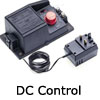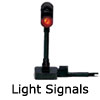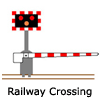Model Railway Electrics -
Switches



Point motor switches
I know what you're thinking switches
are easy, but point motor switches are not like normal switches.
A point motor requires only a short burst of electricity. Hornby
use what is called a passing contact switch. This means it only
supplies a short burst of electricity to make the points change.
The problem with Hornby switches is their cost (£5 RRP). This
means they cost more than the point motor (£3.85 RRP) and
together with the cost of Hornby standard points (£6.50 RRP) the
cost of each motorised set of points is a whopping £15.35 RRP.
That's £30+ for a set of change over points and £60+ for the
return.
I strongly recommend that you use toggle
switches (on-(off)-on) or two push switches which are available form any
good electronics firm or
New Modellers Shop. These switches return to the centre when
pressed so that you only supply that short burst of power, that the point
motors need. Point motors can burn out if you don't use a short burst of
power. A Capacitor Discharge Unit will help protect your point motors.
I would also recommend toggle switches for the
signals (on-on) as well as any lights or isolating sections you have
(on-off) as Hornby alternatives are also £5. A standard toggle switch should
be about 20p.



on-on R046
on-off R047
Point Motor Switch
R044
There are advantages of using Hornby's system.
All three types of switch, interlock to make an attractive and functional
switch board and because they are large, you get the feel you are in control
of a real railway. Unlike the toggle switch, the Hornby switch shows the
position of the points either open or closed. The toggle switch returns to
the centre when it is pressed and thus does not show the position of the
points. If you haven't got a good memory then you will have to use the
Hornby point switch. The Hornby switches are also spring loaded in one
direction. If cost is not a problem I would go for the Hornby switches
(point switches especially due to showing the points position) especially if
the layout is to be used by children.
[back to the top]
Wiring Multiple
Point Motors
Point motors need to be wired
independently to its switch. It is only the centre wire (in my case black)
of both the point motor and switch which are wired to the low voltage power
output and can share a wire with other points. See the circuit diagrams
below. On the left you can see three point motors connected to three toggle
switches. On the right you can see three point motors connected to six push
button switches (one for open, one for close on each point).


[back to the top]
SPDT (on-on toggle switch) And Push To Make Point Switching (Idea
from Mr Bulmer)
This method of switching point gets around the problem of not
knowing the position of the points. By using an on-on switch to change the
direction of the point motor, and a "push to make switch" to activate the
movement. (See circuit diagram below)

The
on-on switch directs the power to either side of the point motor. If this was
connected to the power supply the point motor would burn out as it would get a
constant flow of power. By putting a "push to make switch" between the on-on
switch and the power transformer, you can trigger a short burst of power to
change the point.
So to
change the point you position the on-on switch, and then push the "push to make
switch" to trigger the burst. The position of the on-on switch illustrates the
position of the point. It would be a good idea if you position them on a control
board with a diagram of the layout so you know what the switch position means.
Problems:
The position of the on-on switch, does not tell you if the point has actually
changed. The only way to show the position of the points remotely, is to fix a
switch to the point which changes a light on the control board. If you do this
you might as well use the toggle switches (on-(off)-on) or two push switches.
Warning point motors can burn out if you don't use a short burst of power. A
Capacitor Discharge Unit will help protect your point motors
Advantages: Less wiring than using lights to illustrate the position of the points and its
cheaper.
[back to the top]
SPDT Switching (suggested by LisaP4)
Instead of using a push to make switch, this method
uses two diodes and a capacitor to fire a short bursts of power to throw the
point switch. (see circuit diagram below)

When the switch is thrown, the current flows through
the point motor until the capacitor is fully charged and then it stops. When you
then through the switch in the opposite direction the capacitor discharges
through the other side of the point motor making it move in the opposite
direction from before until the capacitor is fully discharged. Both times the
switch is thrown the point motor only gets a very small burst of power.
Problems: Only the added time in wiring which makes this more complex. I
have only run this on a test rig using 12v DC and it works but with little
power. I think you need the 16-24v which was suggested.
Advantages: Only need one switch. Basically it works like Hornby and Peco
point switches except it requires DC to work. You should not require a Capacitor
Discharge Unit as the capacitor does this job.
[back to the top]
Mimic
Board
Another method of changing the points is using a mimic board. This article
was written by Mr Breakwell
"If your after cheep way of wiring point motors,
terminate the two wires from your motor directly on your control panel with
self taping screws. Terminate the power wire (from the controller) the same
way in the upper centre of the panel. You will need to extend the power wire
with a trailing wire. This should be a strong flexible multi core wire (the
type used in cars) Fix one end with a spade fitting to fit under the screw
to contact the power wire and the other end can be cut off clean leaving the
wire insulated."
"To operate the
point touch the trailing wire on self taping screw you'll find you have to
hold the trailing wire vertical because of the insulation (do not keep it in
contact, just one touch should do) I have made a diagram to assist my
explanation."

Click here to
enlarge image
"There are two
problems.
1.
You may have to reverse the wires from the points to activate them on the
correct track.
2. You can't identify from
the control panel, which track was selected last ? This can be solved using
a Peco Accessory Switch (PL-13) which is mounted on the point to change an
led on the control panel to indicate the position of the point (green for
straight and red for bend). This could also change a signal at the same
time.
3.
Warning point motors can burn out if you don't use a short burst of power. A
Capacitor Discharge Unit will help protect your point motors
Advantages:
Very Cheap!!
it works for me hope it works for you.... Mr
Breakwell"
Electronic component retailers are an endless source
of cheap electronic components that will allow you to do almost anything to you
layout. You can find a selection of the components I have used at this site
new
modellers shop
[back to the top]
















|






